Cherry trees (Prunus spp.) exist in a huge variety, both ornamental and cultivated. Those varieties are often hard to tell apart, or even to tell apart from closely related fruit trees. The appearance of blossoms, leaves and fruit can be used to distinguish the cherry tree species from one another.
Cherry trees have two kinds of flower arrangement, which is one of the easiest ways to start cherry tree identification. Their flowers either cluster on the ends of branches in cylinder-shaped spikes of 10 or more blooms or their flowers appear on branches singly or in clusters of 10 or fewer stemming from a central point.
Cherry tree fruit varies from bright yellows and blushes to dark purple and black shades, depending on the tree species. Many cherries are ornamental and produce little to no fruits. Most ornamental cherry trees bloom in spring, though the exact timing depends on the specific variety and climate. The flowers themselves are usually some combination of white, pink and lavender.
The cherry tree is the most widely planted ornamental tree in the United States. Cherry trees require cold weather to flower and fruit, so they do not grow in tropical climates and would not grow well indoors. They grow best in sites with acidic soil featuring full sun to partial shade.
Cherry trees have numerous uses in landscape design. Depending on the variety you choose, these small trees make ideal privacy screens, edible hedges or street trees. You can even grow some cherry trees as a bonsai or in containers.
- Weeping Cherry Tree (Prunus subhirtella)
- Tart/Sour Cherry (Prunus cerasus)
- Sweet Cherry Tree (Prunus avium)
- Tibetan Cherry (Prunus serrula)
- Japanese Cherry Tree / Sakura
- Sargent’s Cherry Tree (Prunus sargentii)
- Yoshino Cherry Tree (Prunus yedoensis)
- Higan Cherry Tree (Prunus subhirtella)
- North Star cherry
- Vandalay Cherry
- Nanking cherry (Prunus tomentosa)
- Montmorency cherry
- Stella Cherry (Prunus avium “Stella”)
- Benton cherry
- Black cherry (Prunus serotina)
- Bird Cherry
- Lapins cherry
- Accolade Cherry
- Rosebud Cherry
- Akebono Cherry
- Carmine Jewel cherry
- Kwanzan Cherry
Types of Cherry
Weeping Cherry

Weeping cherry trees bear either white or pink spring blossom, with single or double flowers.These trees flower before the leaves appear each year. The shape of the tree, with weeping branches, is distinctive at all times, and in spring and summer the branches are clothed with large, ovate, toothed glossy leaves which give way to golden tones in fall. In winter, the bronze bark stands out.
All weeping cherries are compact in habit.Standard-sized weeping cherries reach 20 feet tall with a weeping canopy spreading 20 feet wide. They are ideal for small spaces as both the height and spread are limited, and so they make lovely specimen trees to grow in a lawn, a courtyard, or a border.
Sour Cherry

Sour, tart or pie cherry provides both beautiful flowers in spring and a tangy, acidic fruit in early summer often before other plants in the garden show any sign of life. The trees grow only about 20 feet tall. When allowed to grow unpruned, sour cherries can reach heights of up to 50 feet, but for maximum fruit set and ease of care, trees are usually pruned to stay around 20 feet high.
The bark of the tree is reddish-brown and shiny, with peeling horizontal strips. The branches spread upwards and have smooth twigs. Sour cherry is closely related to the sweet cherry but has a fruit that is more acidic. Its sour pulp is edible. Sour cherry trees tolerate a variety of soil types, but produce best in rich, well-drained soil in full sun. The ideal planting location is a raised bed or berm to facilitate drainage. Sour cherry trees are much more cold hardy and less prone to disease.
Also Read: Crabapple Varieties In United States
Sweet Cherry
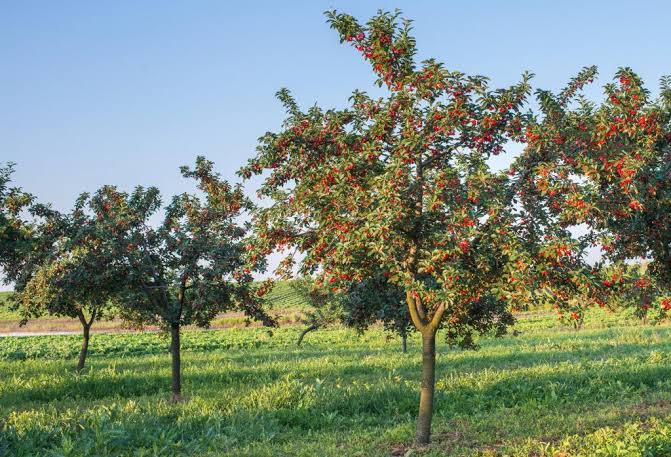
Sweet cherry trees look like sour cherry trees but the two are quite different. Sweet cherries bear abundant, sweet fruit that is delicious for fresh eating whereas Sour Cherry fruit is, as the name implies, usually tart, and is best used in pies and preserves. Sour cherry trees are much more cold hardy and less prone to disease.
Sweet cherry trees reach as high as 35 feet with some varieties spreading nearly as wide, while those grown on dwarf rootstock remain easily managed at 20 feet high.These trees take a natural pyramid form and are usually grown as small to medium trees, or they can be trained to fan out against a wall or fence. These trees are deciduous, with deep green leaves emerging in spring, then developing to bronze and gold in fall.
Sweet cherry trees bloom early in spring, with highly fragrant, pretty white flowers. These bloom in small clusters along the branches, before giving way to abundant crops of glossy, sweet cherries. The size and color of the fruit will differ between varieties.
Tibetan cherry
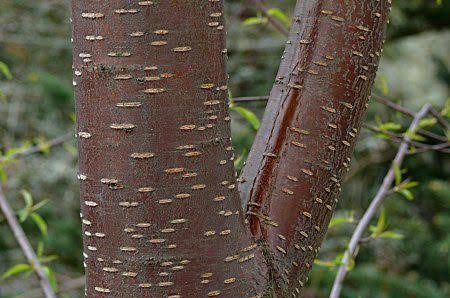
Tibetan cherry also referred to as birch bark cherry, birchbark cherry or paperbark cherry is a magnificent tree for year round interest with its eye-catching polished, striking, coppery-red bark. Sturdily growing specimens have the most beautiful trunks. The tree also has a naturally rounded habit, and can also be grown as a large shrub.
In spring, it bears bowl-shaped white flowers just before the leaves emerge, which are followed by small cherries in summer. In autumn, its green leaves turn yellow before they fall. It is often grown as a multi-stemmed or short stemmed tree with a wide crown.This is a slow-growing tree that will grow in almost any soil type, though it prefers a moist and well-draining soil with some organic content and offcourse full sun or partial shade. It will reach 8m (25ft) possibly a little more in ideal conditions.
Japanese Cherry

Japanese flowering cherry, sometimes referred to as the “royal Japanese cherry tree” or simply the “Japanese cherry tree,” is a distinctive tree known for its pink and white cherry blossoms. These blossoms, which bloom for only a short period of time each spring, fall off the trees to create a snow-like effect on the ground beneath. Japanese flowering cherry is a desirable tree for any landscape and as a result, the tree is a popular ornamental plant both in Japan and across the globe.
Japanese cherry trees mature up to approximately 30 feet tall and 25 feet wide. The different varieties range in size and growth habit, but all provide abundant spring blossoms. A healthy Japanese cherry tree can live as long as 150 years. The average lifespan, however, reaches only 20 years, due to the tree’s high susceptibility to insects and disease. You can prolong the tree’s life by using mulch to trap moisture into its root system during dry spells and preventing pest infestations.
Sargent’s Cherry

Sargent’s cherry also referred to as North Japanese hill is an upright-spreading to rounded tree, with deep reddish brown, polished bark. Growing at a moderate rate into a 20 to 25-feet high, Sargent’s cherry makes an ideal shade tree, spreading as wide as it is tall and casting dense shade below. It is often grown with several multiple trunks or upright branches originating from the same position on the trunk ascending in a graceful fashion.
The Sargent cherry offers year-round beauty. Pink blooms adorn the tree in late spring, the leaves unfurl with a purplish or bronze hue that transitions to a shiny dark green into summer, and then red, orange and bronze in the fall; and the winter landscape benefits from its attractive bark.
Also Read: Varieties of Trees With Beautiful Fall Color
Pink Star Cherry

Pink star cherry is an excellent plant that adds interesting characteristics to the landscape at any time of year. Pink star flowering cherry has an umbrella-shaped canopy that reaches 25 feet tall. Its fragrant, pink flowers blossom in spring and its leaves turn red, orange, bronze or gold in fall.
This faster-growing landscape tree stands out as a specimen in a lawn or landscape bed, but it can also work well along the entry to a subdivision, for commercial landscape in centers, or in the tree lawn space between curb and sidewalk.
Yoshino Cherry

Yoshino flowering cherry, also known as Potomac cherry and Tokyo cherry, is a hybrid that was developed in Japan. The tree has a canopy in an oval, rounded or umbrella shape that reaches between 20-30 feet tall. Its fragrant pink flowers blossom in winter or spring, and its leaves turn bronze or gold in fall. Yoshino cherries are fast-growing trees and widely considered one of the most beautiful flowering ornamental trees.
A deciduous tree, the Yoshino cherry has oval, dark-green leaves that turn yellow in fall. Its flowers are slightly fragrant and single petaled, opening in four-blossom clusters in late March or early April. They appear in masses that cover the tree’s branches before its leaves appear, making a contrasting display against the tree’s darkly colored trunk and branches.Yoshino cherries are fast-growing trees.
Higan Cherry

Higan cherry is popular for its ability to produce lovely pink buds and white flowers off and on during a warm autumn season and then fully flower in the spring. In addition to the sporadic fall bloom, the foliage turns bronze, yellow, gold, or deep-red tinged to contribute to the beauty of the season. Even the shiny red-toned bark is attractive.
This medium-sized tree works as a specimen feature on large lawns and, typically, can grow up to 30 feet tall. It’s relatively easy to care for and doesn’t require a great deal of maintenance.This spectacular, fast-growing, flowering cherry tree is a landscape stand-out with seasonal interest.
North Star cherry

The North Star cherry is a sour cherry tree. A dwarf cultivar, it typically grows 8 to 10 feet tall with a spread of 6 to 8-feet. These features make this tree a great choice for even the smallest gardens.The bark is smooth and brownish gray in color with white lenticels. Leaves are in an opposite arrangement and are dark green in the summer. The flowers are white and bloom in the spring. It produces one crop per year of large bright red cherries. The sour cherries are ready for harvest in June. The ‘North Star’ is self-pollinating.
Also Read: Different Types of Flowering Trees
Vandalay Cherry
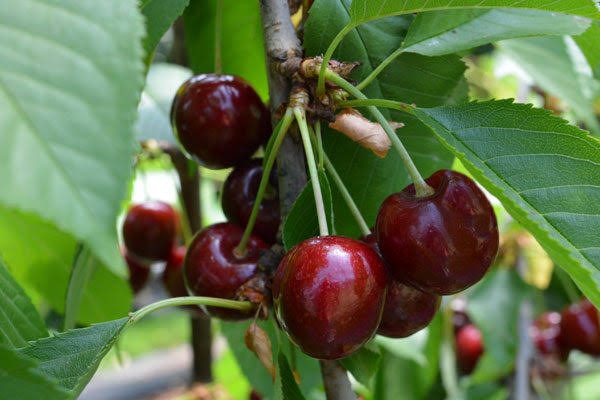
This cultivar is a crossbreed between Stella and Van varieties. First developed in Toronto, Canada in the late nineties, it’s a relatively newcomer to the cherry scene. The Vandalay cherry tree produces fruit that is deep red on the outside, with wine-red flesh. The cherries are kidney-shaped and very attractive. They are also sweet and delicious, excellent for eating fresh from the tree but also perfect for use in pastries.
From planting to maturity, Vandalay cherry trees require countless hours of maintenance to ensure that their branches grow into a suitable shape, their growth rate is healthy and adequate, their wood and foliage remains disease and pest free and that they produce an abundant crop. With properly timed care and training, your homegrown Vandaley cherry tree will provide beauty to your landscape and fresh fruit for your table.
Nanking Cherry
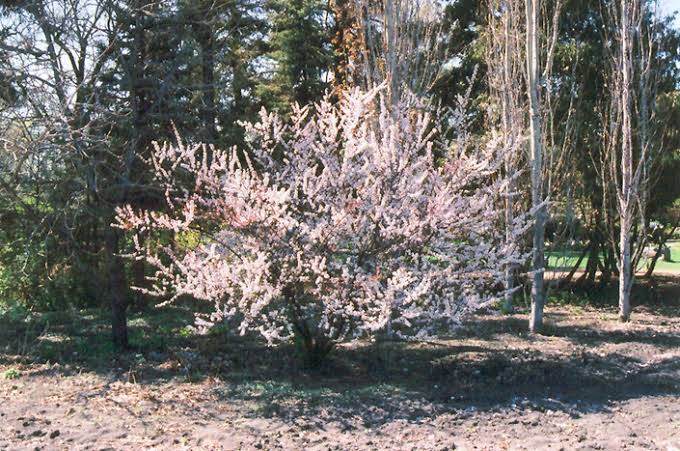
Nanking cherries are sometimes referred to as Manchu cherry, downy cherry, mountain cherry or Mongolian cherry, is a fast-growing species that sets fruit within two years. Without pruning, a Nanking bush cherry tree can reach heights of 15 feet (4.5 m.), but the spreading growth habits of the Nanking cherry allow it to grow as a shrub or planted closely and trimmed into a hedge. It’s an early spring bloomer producing attractive pink buds that turn white as they flower.
Nanking cherry are particularly well adapted to nearly every climate and condition, including extreme cold, extreme heat, arid conditions, high elevation, and nearly all soil types. They are well adapted to the Intermountain climate and conditions, and can produce fruits even if flowers are exposed to late spring frosts.
Montmorency Cherry
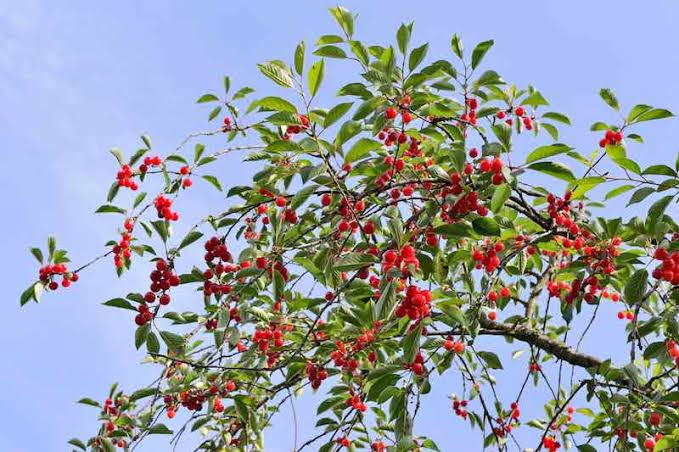
Montmorency cherry is a medium to large cherry tree of rounded habit, with upright spreading branches featuring leathery elliptic dark green leaves with pale green undersides. In spring the tree is ardoned with an abundance of white flowers in clusters along the branches. They are followed by a heavy crop of medium-large bright red fruits with a firm yellow flesh in early summer. The fruits are characterized by a rich, tangy flavor.
Montmorency cherries are cold-hardy hybrid species and the most widely cultivated type of sour cherry for commercial uses in the United States. Therefore, chances are if you have ever had a product with tart cherries in it, you’ve had a Montmorency. These cherries are available fresh during July and August, but are most often consumed canned, frozen or dried.
Black Cherry

Prunus serotina, commonly called black cherry, wild black cherry, rum cherry, or mountain black cherry, is a deciduous native tree found in the Midwest and throughout the eastern United States.It commonly attains heights of 55 feet and diameters of up to 2 feet on good sites; on less desirable sites it is often much smaller in size.
The tree has alternate leaves with a finely toothed margin, inconspicuous glands on the stem, and yellow-brown pubescence on the underside of the leaf. The bark of the tree is marked by horizontal lenticels. As the tree ages, it exhibits a scaly or flaky pattern. The showy white flowers appear as pendulous clusters in early spring, followed by dark, pea-sized fruits in late summer.
Stella Cherry

The Stella cherry tree is a self-fertile, deciduous cherry tree that thrives in full sun and moist but well-drained soil. Excellent as a self-fruitful tree and a pollenizer for other cherry trees. “Stella” cherry trees are a hybrid from the “Lambert” black cherry and their cherries are similar.
The Stella cherry tree reaches about 15 to 20 feet in height and produces showy white flowers in the spring followed by sweet cherries that are ready for harvest in mid-summer. Its richly flavored, sweet cherries are dark red to nearly black. They are about 1 inch wide, firm and resist cracking from the rain.
Benton Cherry

Benton cherry is a cross between the Beaulieu and Stella cultivars. The Beaulieu helped produce a faster ripening fruit and the Stella enhanced the cherry’s sweetness. Benton cherry trees tend to be quite large with upright branches that spread out wide. The tree’s leaves have the typical lance-like cherry shape with gently serrated edges. Blossoms are a striking white and generally shows up mid-to-late in the season.
The Benton’s large fruits are dark red with a lighter red flesh. Inside is a semi-freestone. The Benton cherry usually ripens before other varieties, like the Bing, and finishes up by mid-season. These trees are tough and resistant to rain cracking.
Benton cherries are known for their complex sweetness and how easy they are to raise. Benton cherries are more forgiving than other cherry trees and take less maintenance. They are also highly disease-resistant. Benton cherries also make a great addition to virtually any style of landscaping.
Also Read: Trees With Pink Flowers
Bird cherry
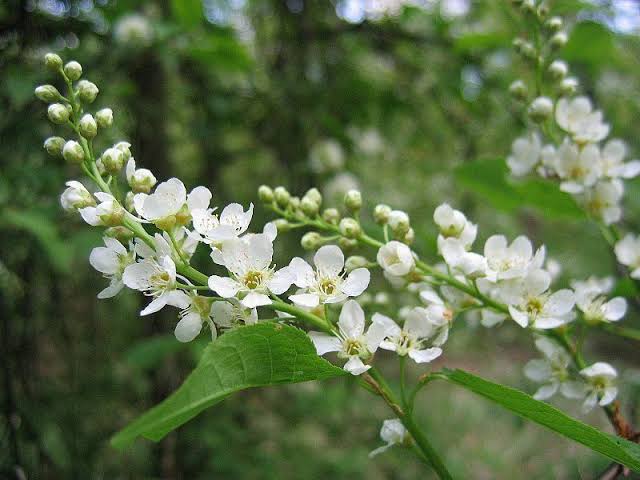
Prunus padus, known as bird cherry, hackberry, hagberry, or Mayday tree. Bird cherry trees are native to Britain and look stunning in late spring when they are covered with masses of white almond scented fragrant blossom.The flowers are followed by small, bitter fruits, much relished by local wildlife. Bird Cherry’s foliage then turns golden-yellow in autumn for additional seasonal interest. Bird Cherry hedge plants are also great for a stand-alone hedge, specimen tree or when grown as a hedgerow tree.
Lapins cherry

Lapins is a cultivar of cherry. It is a hybrid of the Van and Stella cultivars. The Lapins cherry tree grows to 2.5 to 4 meters tall, with a 2.5 to 4 meters spread. It has dense, green foliage and a branch structure conducive to heavy yields. Like its parent variety Stella, the Lapins cherry is self-fertile and an excellent pollinator for other cherry varieties.
A Lapins cherry tree produces dark, sweet fruit that is very similar to the popular Bing cherry. Lapins cherries are a large varietal, averaging 2 to 4 centimeters in diameter, and have a cordate, round, to sometimes conical shape attached to a slender and fibrous, green-brown stem.The fruit’s skin is glossy, taut, and thin, showcasing vibrant ruby to crimson hues.
Accolade Cherry
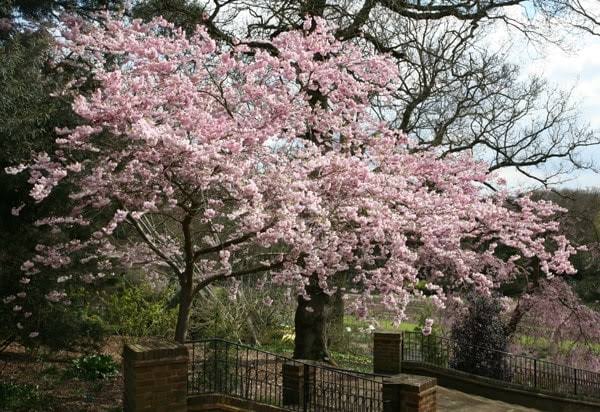
Accolade cherry is a cross between Sargent’s cherry which forms good autumn colour and Hogan cherry which shows in the lightly twigged nature of its branching and early flowering. Reaching a maximum height of 8m (24ft) with a 5m (16ft) spread this is an ideal flowering tree for a small garden.
Accolade is a small spreading tree with lots of pink semi-double flowers which later fade to pale pink. One of the earliest flowering cherries it starts to blossom at the beginning of April, it blooms very abundantly even as a young tree.
Conclusion
Prunus is a wide genus that includes several fruit trees and their closely related ornamental cousins. Among the cherry tree varieties list, you can find white, black, red cherry, bush, early, late, best cherries, self pollinating, small, big cherry, sweet cherry varieties.
Further References
- Facts About Cherry Trees: https://en.m.wikipedia.org/wiki/Cherry
- How To Grow Cherry Trees: https://www.gardeningknowhow.com/edible/fruits/cherry/cherry-tree-care.htm
- Types of Cherry Trees: https://gardenerspath.com/plants/fruit-trees/grow-fruiting-cherry/
- Cherry Trees For Sale: https://www.fast-growing-trees.com/collections/cherrytrees
- Cherry Tree Diseases And Pests: https://plantvillage.psu.edu/topics/cherry-including-sour/infos